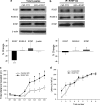R7BP complexes with RGS9-2 and RGS7 in the striatum differentially control motor learning and locomotor responses to cocaine
- PMID: 20043004
- PMCID: PMC2887292
- DOI: 10.1038/npp.2009.212
R7BP complexes with RGS9-2 and RGS7 in the striatum differentially control motor learning and locomotor responses to cocaine
Abstract
In the striatum, signaling through G protein-coupled dopamine receptors mediates motor and reward behavior, and underlies the effects of addictive drugs. The extent of receptor responses is determined by RGS9-2/Gbeta5 complexes, a striatally enriched regulator that limits the lifetime of activated G proteins. Recent studies suggest that the function of RGS9-2/Gbeta5 is controlled by the association with an additional subunit, R7BP, making elucidation of its contribution to striatal signaling essential for understanding molecular mechanisms of behaviors mediated by the striatum. In this study, we report that elimination of R7BP in mice results in motor coordination deficits and greater locomotor response to morphine administration, consistent with the essential role of R7BP in maintaining RGS9-2 expression in the striatum. However, in contrast to previously reported observations with RGS9-2 knockouts, mice lacking R7BP do not show higher sensitivity to locomotor-stimulating effects of cocaine. Using a striatum-specific knockdown approach, we show that the sensitivity of motor stimulation to cocaine is instead dependent on RGS7, whose complex formation with R7BP is dictated by RGS9-2 expression. These results indicate that dopamine signaling in the striatum is controlled by concerted interplay between two RGS proteins, RGS7 and RGS9-2, which are balanced by a common subunit, R7BP.
Figures






Similar articles
-
Macromolecular composition dictates receptor and G protein selectivity of regulator of G protein signaling (RGS) 7 and 9-2 protein complexes in living cells.J Biol Chem. 2013 Aug 30;288(35):25129-25142. doi: 10.1074/jbc.M113.462283. Epub 2013 Jul 15. J Biol Chem. 2013. PMID: 23857581 Free PMC article.
-
Changes in striatal signaling induce remodeling of RGS complexes containing Gbeta5 and R7BP subunits.Mol Cell Biol. 2009 Jun;29(11):3033-44. doi: 10.1128/MCB.01449-08. Epub 2009 Mar 30. Mol Cell Biol. 2009. PMID: 19332565 Free PMC article.
-
The membrane anchor R7BP controls the proteolytic stability of the striatal specific RGS protein, RGS9-2.J Biol Chem. 2007 Feb 16;282(7):4772-4781. doi: 10.1074/jbc.M610518200. Epub 2006 Dec 7. J Biol Chem. 2007. PMID: 17158100
-
R9AP and R7BP: traffic cops for the RGS7 family in phototransduction and neuronal GPCR signaling.Trends Pharmacol Sci. 2009 Jan;30(1):17-24. doi: 10.1016/j.tips.2008.10.002. Epub 2008 Nov 29. Trends Pharmacol Sci. 2009. PMID: 19042037 Free PMC article. Review.
-
RGS Proteins as Critical Regulators of Motor Function and Their Implications in Parkinson's Disease.Mol Pharmacol. 2020 Dec;98(6):730-738. doi: 10.1124/mol.119.118836. Epub 2020 Feb 3. Mol Pharmacol. 2020. PMID: 32015009 Free PMC article. Review.
Cited by
-
Differential localization of G protein βγ subunits.Biochemistry. 2014 Apr 15;53(14):2329-43. doi: 10.1021/bi500091p. Epub 2014 Apr 1. Biochemistry. 2014. PMID: 24568373 Free PMC article.
-
The in vivo specificity of synaptic Gβ and Gγ subunits to the α2a adrenergic receptor at CNS synapses.Sci Rep. 2019 Feb 8;9(1):1718. doi: 10.1038/s41598-018-37222-1. Sci Rep. 2019. PMID: 30737458 Free PMC article.
-
R7BP modulates opiate analgesia and tolerance but not withdrawal.Neuropsychopharmacology. 2012 Mar;37(4):1005-12. doi: 10.1038/npp.2011.284. Epub 2011 Nov 16. Neuropsychopharmacology. 2012. PMID: 22089315 Free PMC article.
-
Striatal RGS7 Regulates Depression-Related Behaviors and Stress-Induced Reinstatement of Cocaine Conditioned Place Preference.eNeuro. 2021 Mar 10;8(2):ENEURO.0365-20.2020. doi: 10.1523/ENEURO.0365-20.2020. Print 2021 Mar-Apr. eNeuro. 2021. PMID: 33402347 Free PMC article.
-
Translational relevance of forward genetic screens in animal models for the study of psychiatric disease.Neurosci Biobehav Rev. 2022 Apr;135:104559. doi: 10.1016/j.neubiorev.2022.104559. Epub 2022 Feb 4. Neurosci Biobehav Rev. 2022. PMID: 35124155 Free PMC article. Review.
References
-
- Anderson GR, Semenov A, Song JH, Martemyanov KA. The membrane anchor R7BP controls the proteolytic stability of the striatal specific RGS protein, RGS9-2. J Biol Chem. 2007a;282:4772–4781. - PubMed
Publication types
MeSH terms
Substances
Grants and funding
- P01 NS047399/NS/NINDS NIH HHS/United States
- R01 DA019666/DA/NIDA NIH HHS/United States
- DA026405/DA/NIDA NIH HHS/United States
- P50 DA011806/DA/NIDA NIH HHS/United States
- DA021743/DA/NIDA NIH HHS/United States
- NS047399/NS/NINDS NIH HHS/United States
- K02 DA026405/DA/NIDA NIH HHS/United States
- DA011806/DA/NIDA NIH HHS/United States
- MH061933/MH/NIMH NIH HHS/United States
- DA019666/DA/NIDA NIH HHS/United States
- R01 MH061933/MH/NIMH NIH HHS/United States
- R01 DA021743/DA/NIDA NIH HHS/United States
- F31 DA024944/DA/NIDA NIH HHS/United States
LinkOut - more resources
Full Text Sources
Molecular Biology Databases

